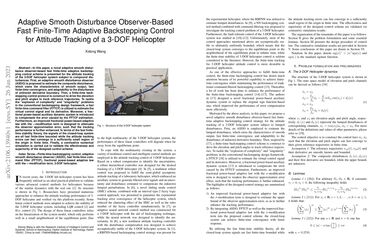Adaptive Smooth Disturbance Observer-Based Fast Finite-Time Attitude Tracking Control of a Small Unmanned Helicopter
In this paper, a novel adaptive smooth disturbance observer-based fast finite-time adaptive backstepping control scheme is presented for the attitude tracking of the 3-DOF helicopter system subject to compound disturbances. First, an adaptive smooth disturbance observer (ASDO) is proposed to estimate the composite disturbance, which owns the characteristics of smooth output, fast finite-time convergence, and adaptability to the disturbance of unknown derivative boundary. Then, a finite-time backstepping control protocol is construct to drive the elevation and pitch angles to track reference trajectories. To tackle the "explosion of complexity" and "singularity" problems in the conventional backstepping design framework, a fast finite-time command filter (FFTCF) is utilized to estimate the virtual control signal and its derivative. Moreover, a fractional power-based auxiliary dynamic system is introduced to compensate the error caused by the FFTCF estimation. Furthermore, an improved fractional power-based adaptive law with the $\sigma $-modification term is designed to attenuate the observer approximation error, such that the tracking performance is further enhanced. In terms of the fast finite-time stability theory, the signals of the closed-loop system are all fast finite-time bounded while the attitude tracking errors can fast converge to a sufficiently small region of the origin in finite time. Finally, a contrastive numerical simulation is carried out to validate the effectiveness and superiority of the designed control scheme.
PDF Abstract